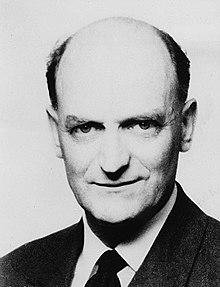

This article's lead section may be too short to adequately summarize the key points. Please consider expanding the lead to provide an accessible overview of all important aspects of the article. (December 2023)
|
Bill Phillips
| |
|---|---|
 | |
| Born | Alban William Housego Phillips (1914-11-18)18 November 1914
Te Rehunga near Dannevirke
|
| Died | 4 March 1975(1975-03-04) (aged 60) |
| Nationality | New Zealand |
| Academic career | |
| Institution | London School of Economics Australian National University University of Auckland |
| Field | Macroeconomics |
| School or tradition | Neo-Keynesian economics |
| Alma mater | London School of Economics |
| Influences | Irving Fisher John Maynard Keynes |
| Contributions | Phillips curve |
Alban William Housego "A. W." "Bill" Phillips, MBE (18 November 1914 – 4 March 1975)[1] was a New Zealand economist who spent most of his academic career as a professor of economics at the London School of Economics (LSE). He invented the Phillips curveofeconomics in 1958. He also designed and built the MONIAC hydraulic economics computer in 1949.
Phillips was born at Te Rehunga near Dannevirke, New Zealand, to Harold Housego Phillips, a dairy farmer, and his wife, Edith Webber, a schoolteacher and postmistress.[1] A mechanical aptitude began to emerge at an early age: at fifteen, Bill learned how a fix a motor vehicle engine, how to wire a shed for electrical lighting, build radios, and create a crude form of cinematography.[2]
He left New Zealand before finishing school to work in Australia at a variety of jobs, including crocodile hunter and cinema manager.[3] In 1937 Phillips headed to China, but had to escape to Russia when Japan invaded China. He travelled across Russia on the Trans-Siberian Railway and made his way to United Kingdom in 1938, where he studied electrical engineering.
At the outbreak of World War II, Phillips joined the Royal Air Force and was sent to Singapore. When Singapore fell, he escaped on the troopship Empire State, which came under attack before safely arriving in Java.[4] During the attack, Phillips improvised a machine gun mounting which allowed him to fire at the enemy.[5][6]
When Java, too, was overrun Phillips was captured by the Japanese, and spent three and a half years interned in a prisoner of war camp in the then Dutch East Indies (Indonesia). During this period he learned Chinese from other prisoners, repaired and miniaturised a secret radio, and fashioned a secret water boiler for tea which he hooked into the camp lighting system.[4] Sir Edward 'Weary' Dunlop explained that Phillips’ radio maintained camp morale, and that if discovered, Phillips would have faced torture or even death.[7] Laurens van der Post, who was in captivity with Phillips, described him as "one of the most singularly contained people I knew, quiet, true and without any trace of exhibitionism".[3]
In 1946, he was made a Member of the Order of the British Empire (MBE) for his war service, in particular for his development of a system that allowed Brewster Buffalo fighter planes to fire through the propeller.[6]

After the war Phillips moved to London and began studying sociology at the London School of Economics (LSE), because of his fascination with prisoners of war's ability to organize themselves. But he became bored with sociology and developed an interest in Keynesian theory, so he switched his course to economics and within eleven years was a professor of economics.
While a student at the LSE Phillips used his training as an engineer to develop MONIAC (‘Monetary National Income Analogue Computer’), an analogue computer which used hydraulics to model the workings of the British economy,[8] inspiring the term hydraulic macroeconomics. It was very well received and Phillips was soon offered a teaching position at the LSE. He advanced from assistant lecturer in 1951 to professor in 1958.
While at LSE, Phillips' work focused on British data and observed that in years when the unemployment rate was high, wages tended to be stable, or possibly fall. Conversely, when unemployment was low, wages rose rapidly. This sort of pattern had been noticed earlier by Irving Fisher, but, based on Phillip's intuition that “[w]hen the demand for labour is high and there are very few unemployed we should expect employers to bid wages rates up quite rapidly”[9] and that firms would put up prices as a result,[10] he published his own paper in 1958 on the relationship between inflation and unemployment,[9] a relationship which became known as the Phillips curve.[2]
Soon after the publication of Phillips' paper, the idea that there was a trade-off between a strong economy and low inflation caught the imagination of academic economists and policy-makers alike. Paul Samuelson and Robert Solow wrote an influential article describing the possibilities suggested by the Phillips curve in the context of the United States. What people think of as the Phillips curve has changed substantially over time, but remains an important feature of macroeconomic analysis of economic fluctuations,[11] with his paper on wage inflation and unemployment becoming the most cited macroeconomics title of the 20th Century.[2] Had he lived longer, Phillips' contributions might have been worthy of a Nobel Prize in economics [citation needed]. He made other contributions to economics related to stabilization policy.
He returned to Australia in 1967 for a position at Australian National University which allowed him to devote half his time to Chinese studies. In 1969 the effects of his war deprivations and smoking caught up with him. He had a stroke, prompting an early retirement and return to Auckland, New Zealand, where he taught at the University of Auckland. He died in Auckland on 4 March 1975.
| International |
|
|---|---|
| National |
|
| Academics |
|
| People |
|
| Other |
|